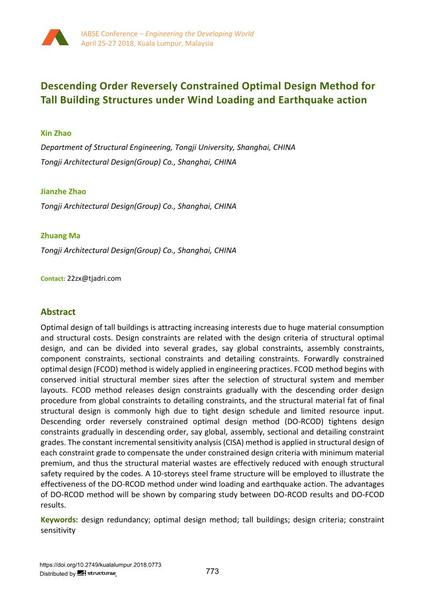Descending Order Reversely Constrained Optimal Design Method for Tall Building Structures under Wind Loading and Earthquake action

|
|
|||||||||||
Détails bibliographiques
| Auteur(s): |
Xin Zhao
(Department of Structural Engineering, Tongji University, Shanghai, China Tongji Architectural Design(Group) Co., Shanghai, China)
Jianzhe Zhao (Tongji Architectural Design(Group) Co., Shanghai, CHINA) Ma Zhuang (Tongji Architectural Design(Group) Co., Shanghai, CHINA) |
||||
|---|---|---|---|---|---|
| Médium: | papier de conférence | ||||
| Langue(s): | anglais | ||||
| Conférence: | IABSE Conference: Engineering the Developing World, Kuala Lumpur, Malaysia, 25-27 April 2018 | ||||
| Publié dans: | IABSE Conference Kuala Lumpur 2018 | ||||
|
|||||
| Page(s): | 773-779 | ||||
| Nombre total de pages (du PDF): | 7 | ||||
| DOI: | 10.2749/kualalumpur.2018.0773 | ||||
| Abstrait: |
Optimal design of tall buildings is attracting increasing interests due to huge material consumption and structural costs. Design constraints are related with the design criteria of structural optimal design, and can be divided into several grades, say global constraints, assembly constraints, component constraints, sectional constraints and detailing constraints. Forwardly constrained optimal design (FCOD) method is widely applied in engineering practices. FCOD method begins with conserved initial structural member sizes after the selection of structural system and member layouts. FCOD method releases design constraints gradually with the descending order design procedure from global constraints to detailing constraints, and the structural material fat of final structural design is commonly high due to tight design schedule and limited resource input. Descending order reversely constrained optimal design method (DO-RCOD) tightens design constraints gradually in descending order, say global, assembly, sectional and detailing constraint grades. The constant incremental sensitivity analysis (CISA) method is applied in structural design of each constraint grade to compensate the under constrained design criteria with minimum material premium, and thus the structural material wastes are effectively reduced with enough structural safety required by the codes. A 10-storeys steel frame structure will be employed to illustrate the effectiveness of the DO-RCOD method under wind loading and earthquake action. The advantages of DO-RCOD method will be shown by comparing study between DO-RCOD results and DO-FCOD results. |
||||
